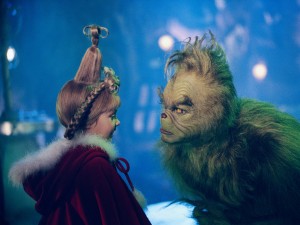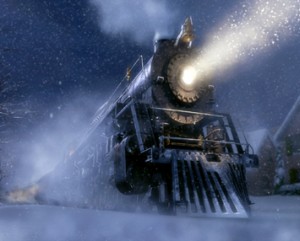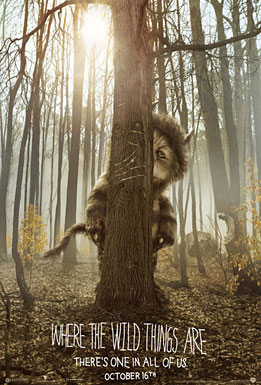 I’ve recently been thinking about what makes a good feature-length movie adaptation of a picture book, and what doesn’t. I’ve decided that I don’t think picture books can be directly adapted for feature films. At least, not in the sense that a novel can. Picture books are an art form altogether different from other types of literature. For me, they are an alchemy of story, poetry, and image, almost impressionistic works. Filmmakers attempting to adapt them have a couple of pretty big obstacles to overcome.
I’ve recently been thinking about what makes a good feature-length movie adaptation of a picture book, and what doesn’t. I’ve decided that I don’t think picture books can be directly adapted for feature films. At least, not in the sense that a novel can. Picture books are an art form altogether different from other types of literature. For me, they are an alchemy of story, poetry, and image, almost impressionistic works. Filmmakers attempting to adapt them have a couple of pretty big obstacles to overcome.
First, while novels aren’t necessarily easy to adapt to the big screen, the challenge for filmmakers is usually to decide what to leave out. The opposite is true of the best picture books, where the essence of the story is so refined, so distilled, so compressed, it’s like looking at a diamond. There is nothing to leave out, and nothing to add. So to reach the hour-and-a-half of a feature length film, directors and screenwriters adapting a picture book have no choice but to “fill” the space between the words and images on the page with something else, and usually that something else is a lot of meaningless fluff. Like a runaway train or an extended song and dance number about hot chocolate. In other words, that’s how you get the Polar Express.
 The second pitfall I see is a tendency to rely on a cinematic “re-creation” of all the pictures from the book. The train coming out of the fog on Christmas Eve, or the Grinch’s lip-curling grin. We expect to see these iconic images, and the stories wouldn’t be complete without them. But there is so much more to a picture book than the pictures. A filmmaker who simply transposes the familiar images to celluloid, thinking that is an adaptation, will ultimately produce something cold and lifeless (again, I direct you to the Polar Express). For a picture book to be adapted, the filmmaker must get at the heart of the story. They have to understand the intent and sensibility of the book’s writer and artist, and enter that world. A striped hat alone does not make the cat.
The second pitfall I see is a tendency to rely on a cinematic “re-creation” of all the pictures from the book. The train coming out of the fog on Christmas Eve, or the Grinch’s lip-curling grin. We expect to see these iconic images, and the stories wouldn’t be complete without them. But there is so much more to a picture book than the pictures. A filmmaker who simply transposes the familiar images to celluloid, thinking that is an adaptation, will ultimately produce something cold and lifeless (again, I direct you to the Polar Express). For a picture book to be adapted, the filmmaker must get at the heart of the story. They have to understand the intent and sensibility of the book’s writer and artist, and enter that world. A striped hat alone does not make the cat.
 All of that being said, I’m really excited about the new Where the Wild Things Are movie precisely because it appears to have avoided the problems I mentioned above. There will certainly be added content (the trailer shows a male figure kissing Max’s mother, which was never in the book) but it appears that Spike Jonze has stayed true to the theme of growing up found in the story. He has taken Sendak’s tale (arguably one of the greatest children’s books of all time, and one of my personal favorites) and made something uniquely his own that is still true to the original. Jonze has created a new story, inspired by Sendak, but with his own unique vision. Ron Howard attempted this with the Grinch, and almost pulled it off. And while Jonze has captured many of the images from the picture book, it looks as though he has given his Wild Things a lot more personality than simply matching their costumes to Sendak’s illustrations. These reasons are why I think this movie might succeed where other attempts to bring a picture book to the screen have not. It’s not actually a strict adaptation.
All of that being said, I’m really excited about the new Where the Wild Things Are movie precisely because it appears to have avoided the problems I mentioned above. There will certainly be added content (the trailer shows a male figure kissing Max’s mother, which was never in the book) but it appears that Spike Jonze has stayed true to the theme of growing up found in the story. He has taken Sendak’s tale (arguably one of the greatest children’s books of all time, and one of my personal favorites) and made something uniquely his own that is still true to the original. Jonze has created a new story, inspired by Sendak, but with his own unique vision. Ron Howard attempted this with the Grinch, and almost pulled it off. And while Jonze has captured many of the images from the picture book, it looks as though he has given his Wild Things a lot more personality than simply matching their costumes to Sendak’s illustrations. These reasons are why I think this movie might succeed where other attempts to bring a picture book to the screen have not. It’s not actually a strict adaptation.
On a side note, I’m thrilled that it seems the filmmakers have elected to keep the effects CGI-less. The Wild Things remind me of the best Jim Henson creations in The Dark Crystal and Labyrinth, and I think that’s a very bold, very smart choice.
This is all based on the trailer, of course, and trailers often turn out to be better than the movies themselves. When Wild Things comes out I could find myself very disappointed. But for right now, I am cautiously optimistic. You can watch the trailer below, and see what you think.
6 responses to “Movie Adaptations”
Yeah, picture books and movies, they don’t usually work. I groaned when I heard Wild Things would be a movie. I’m willing to reconsider, but the trailer freaked out when I tried to play it. Guess I’ll have to wait and see when the movie comes out. Jumanji was another exception to the picture-book based movies that don’t work, in my opinion, though it’s been a lot of years since I’ve seen it.
Oops. I mean picture books made into movies, not picture books alone or movies alone.
I will reserve my judgment. As I stated earlier when we began this argument, perfection does not need embellishment, even by Mr. Jonze. And Max with angst? (I’m attempting to make my keyboard form a gurgling throat sound).
That being said I would happily run over small children, old ladies and men with canes to see this.
http://www.kennedy-center.org/calendar/index.cfm?fuseaction=showEvent&event=KKTBD
Along those lines, I would love, love, love to go see Coraline The Musical. With music by Stephin Merritt from the Magnetic Fields, I think it looks absolutely fantastic.
http://www.mcctheater.org/shows/08-09_season/coraline/index.html
I wasn’t a big fan of the stop-motion Coraline movie that came out recently. It wasn’t bad, but for me it failed to capture the true essence and tone of the book. Where the book feels quiet, brooding, sinister, and a little claustrophobic, the movie felt a bit gregarious. (Not to mention the fact that I didn’t care for the addition of the character named “Wighby.”)
Cool! I hadn’t heard about this, but I think it looks good. Adaptations are supertricky, but I agree with your assessment. They have to be their own creation, and they can’t just copy the book. I hate it when people complain about adaptations because they weren’t exactly like the book. Give me a break. My favorite adaptations are the Lord of the Rings movies. Even better than the books, I say.
[…] George immediately come to mind, though I have admittedly not seen a one of them.) Matt Kirby identified the main pitfall of the process when he wrote, “Picture books are an art form altogether different from other types of […]